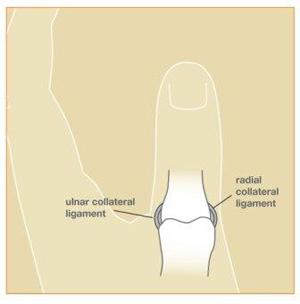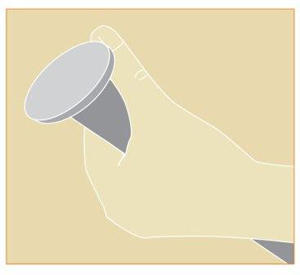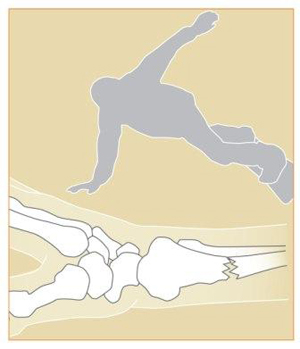Skiing and snowboarding are among the most popular winter sports. Injuries to the upper extremity occur in a relatively predictable pattern. Fortunately, there are some ways to help decrease the chance for injury.
Skiing Injury
The most common upper extremity skiing injury is to a thumb ligament
called the ulnar collateral ligament (UCL) of the metacarpophalangeal
joint. It is the ligament on the inner aspect of the thumb at the second
joint from the thumb tip (see Figure 1). A ligament is the soft tissue
that connects bones to bones. The injury occurs when the ski pole does
not release from the hand and the pole places a bending stress to the
thumb (see Figure 2). If you fall while skiing and your inner thumb
hurts, it may be from a “skier’s thumb,” or UCL
injury, and you should see a hand surgeon. Your surgeon will determine
whether it is a partial or complete ligament tear. A partial tear is
usually treated with a cast or splint, whereas a complete tear is
treated with surgery to repair the ligament since the torn end of the
ligament often gets trapped behind a muscle.

Figure 1: The ulnar collateral ligament (UCL) and the
radial collateral ligament (RCL) help stabilize the thumb.

Figure 2: Upon falling, the ski pole may bend the thumb
in an extreme position and tear the ulnar collateral ligament (UCL), the
so-called “skier’s thumb” injury.
The chance of getting a “skier’s thumb” injury may be decreased by NOT using your ski pole strap around your wrist. Using ski poles without platforms or saber handles decreases your chance of injury. The main goal is that you want the ski poles to release from your hands when you fall. If the ski pole stays in your hand throughout your fall, the pole can act as a long lever arm to put a large stress load on the thumb joint. If you fall, it is better to lose your poles and protect your thumbs.
Snowboarding Injury
The most common snowboarding injury is to the wrist. This may be in
the form of a fracture (broken bone), dislocation, and/or ligament
injury. This usually occurs when the rider falls backwards or forwards
and puts his or her hands out in front of himself or herself to brace
the fall (see Figure 3). If you have this injury, your doctor should
examine your wrist and possibly get more studies such as x-rays and/or
an MRI or CT scan. Depending on the positions of the bones and the
integrity of the ligaments, treatment may consist of a splint, cast, or
even surgery. Occasionally special devices are needed such as metal
pins, plates, screws, or a combination of devices to stabilize wrist
fractures and/or ligament injuries.

Figure 3: Wrist fracture
The chance of suffering a snowboard wrist injury may be decreased by
using wrist guards or gloves that have guards built into them. There are
medical studies that have shown such protective gear to be effective at
decreasing the potential for injury. Regarding protective gear, helmets
have also been shown to decrease head injury and their use should be
encouraged.